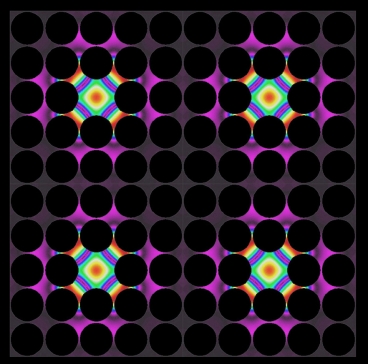Light can be focused and scattered by the lens, but can we allow pure "hot" to "focus" like light? Recently, a researcher at the Massachusetts Institute of Technology (MIT), Martin Maldovan, developed a new technology that allows people to manipulate heat like light.
The key to this technology is the use of nanostructured semiconductor alloy crystals, the theoretical basis of which is that the same heat and sound waves are generated by the atomic lattice vibration of the material. Using this theoretical explanation, the sound is essentially generated by the vibration of a "phonon" (similar to the concept of a photon). We all know that using a photonic crystal (such as a lens) can control the path of light, then the phononic crystal can control the path of the sound. Naturally, "heat phonons crystals" can control the heat path.
Martin Maldova, a research scientist at the Massachusetts Institute of Technology's School of Materials Science and Engineering, explains that the difference between different materials is that they adapt to different wavelengths of different types of energy. The latest study in Maldova was published in the January 11th Physical Review Letters.

As shown above is a thermal energy lattice, which is one of the most likely applications of thermal crystals. In this structure, the accurately arranged air spaces (black circles) will become heat wave conduction paths, and thermal energy will not leak out into the colored area. Image from Martin Maldova.
Mardova explained that the difference between heat and sound is their frequency, the sound frequency is low, in the kilohertz level; heat wave frequency is much higher, in the terahertz (trillion terahertz) level. The use of thermal wave to achieve its control, "This is an unprecedented innovation."
To imitate the means of controlling sound waves to control heat, the primary task of Maldova is to reduce the frequency of these "hot phonons" and make them closer to the frequency range of the sound. Maldova changed this reduced-frequency heat to "hypersonic heat."
"The phonons can reach thousands of miles away, but the thermal phonons can only reach beyond the nanometer. That's why even if terahertz-level vibrations occur, you can't hear the temperature," continued Mardova. The frequency span of sound waves is relatively small, and one reason why heat is harder to control than sound is that the frequency span is too large. Maldova said, "We need to lower its frequency" to reduce the frequency to the edge of heat and sound waves. In order to achieve this goal, he used a silicon material incorporating nano-germanium particles, and made the material into a thin film, which reduced the vibration frequency of the thermal phonons to a desired level.
With this technique, the frequency of heat waves is concentrated to 100 to 300 gigahertz (GHz), and most of the thermal phonons propagate in a specific direction and do not diverge. After achieving this goal, the specific crystal can be used to control the heat wave path by following the working mode of the phononic crystal. Because this crystal is used to control the heat, Maldova creatively called it "thermocrystals", which is an unprecedented type of material.
Thermal crystals have a wide range of applications, such as thermal power generation. The previous thermoelectric materials cannot control the direction of heat. It is like a stone thrown into the water. However, this new technology realizes the directional propagation of heat waves through the treatment of the hot electrons, which can convert heat into electrical energy quickly and easily, and greatly increase the conversion efficiency. Maldova added that the unidirectional propagation of heat waves can also be used to make thermal diodes, and so on.
Another use of this technology is to converge the heat to a very small spot, just like the convex lens converges the light to a point. Using the characteristics of the thermal crystal, people may even create visible light and microwaves that cannot be detected. "Invisible Cloth."
Rama Venkatasubramanian, the senior research director of the Center for Solid State Energetics at RTI International Research Center in North Carolina, says using solid materials to control heat is A very interesting attempt. However, he added that the model is not mature enough. “The theory of different phonon wavelengths is very complicated. The factors that affect the heat conduction rate must also be taken into account. Not to mention nanomaterials, even simple materials are difficult to consider. However, the publication of this study can arouse the interest of many people and lead people to explore more in this direction."
Chunlei Quntification Co.,Ltd , https://www.hychunleitools.com